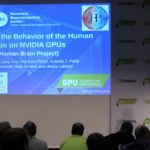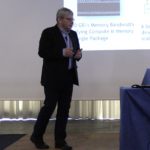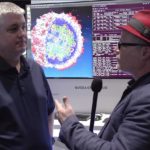Pedro Valero-Lara from BSC gave this talk at the GPU Technology Conference. “The attendees can learn about how the behavior of Human Brain is simulated by using current computers, and the different challenges which the implementation has to deal with. We cover the main steps of the simulation and the methodologies behind this simulation. In particular we highlight and focus on those transformations and optimizations carried out to achieve a good performance on NVIDIA GPUs.”
Inside the Volta GPU Architecture and CUDA 9
“This presentation will give an overview about the new NVIDIA Volta GPU architecture and the latest CUDA 9 release. The NVIDIA Volta architecture powers the worlds most advanced data center GPU for AI, HPC, and Graphics. Volta features a new Streaming Multiprocessor (SM) architecture and includes enhanced features like NVLINK2 and the Multi-Process Service (MPS) that delivers major improvements in performance, energy efficiency, and ease of programmability. You”ll learn about new programming model enhancements and performance improvements in the latest CUDA9 release.”
Brain Research: A Pathfinder for Future HPC
Dirk Pleiter from the Jülich Supercomputing Centre gave this talk at the NVIDIA GPU Technology Conference. “One of the biggest and most exiting scientific challenge requiring HPC is to decode the human brain. Many of the research topics in this field require scalable compute resources or the use of advance data analytics methods (including deep learning) for processing extreme scale data volumes. GPUs are a key enabling technology and we will thus focus on the opportunities for using these for computing, data analytics and visualization. GPU-accelerated servers based on POWER processors are here of particular interest due to the tight integration of CPU and GPU using NVLink and the enhanced data transport capabilities.”
Leadership Computing for Europe and the Path to Exascale Computing
Thomas Schulthess from CSCS gave this talk at the GPU Technology Conference. “With over 5000 GPU-accelerated nodes, Piz Daint has been Europes leading supercomputing systems since 2013, and is currently one of the most performant and energy efficient supercomputers on the planet. It has been designed to optimize throughput of multiple applications, covering all aspects of the workflow, including data analysis and visualisation. We will discuss ongoing efforts to further integrate these extreme-scale compute and data services with infrastructure services of the cloud. As Tier-0 systems of PRACE, Piz Daint is accessible to all scientists in Europe and worldwide. It provides a baseline for future development of exascale computing.”
Pre-exascale Architectures: OpenPOWER Performance and Usability Assessment for French Scientific Community
Gabriel Hautreux from GENCI gave this talk at the NVIDIA GPU Technology Conference. “The talk will present the OpenPOWER platform bought by GENCI and provided to the scientific community. Then, it will present the first results obtained on the platform for a set of about 15 applications using all the solutions provided to the users (CUDA,OpenACC,OpenMP,…). Finally, a presentation about one specific application will be made regarding its porting effort and techniques used for GPUs with both OpenACC and OpenMP.”
How to Prepare Weather and Climate Models for Future HPC Hardware
Peter Dueben from ECMWF gave this talk at the NVIDIA GPU Technology Conference. “Learn how one of the leading institutes for global weather predictions, the European Centre for Medium-Range Weather Forecasts (ECMWF), is preparing for exascale supercomputing and the efficient use of future HPC computing hardware. I will name the main reasons why it is difficult to design efficient weather and climate models and provide an overview on the ongoing community effort to achieve the best possible model performance on existing and future HPC architectures.”
NVIDIA Simplifies Building Containers for HPC Applications
In this video, CJ Newburn from NVIDIA describes how users can benefit from running their workloads in the NVIDIA GPU Cloud. “A container essentially creates a self contained environment. Your application lives in that container along with everything the application depends on, so the whole bundle is self contained. NVIDIA is now offering a script as part of an open source project called HPC Container Maker, or HPCCM that makes it easy for developers to select the ingredients they want to go into a container, to provide those ingredients in an optimized way using best-known recipes.”
Why Use Containers for HPC on the NVIDIA GPU Cloud?
“Containers just make life easy. So one of the things that people have issues with running bare metal is from time to time their libraries change, maybe they want to try the new version of CUDA, the new version of cuDNN, and they forget to simlink it back to the original path. If you have packaged your app into a container, it’s the same every time.”
DDN Powers Data Solutions for AI at the GPU Technology Conference
In this video from the GPU Technology Conference, James Coomer from DDN describes how the company delivers high performance data solutions for machine learning and AI applications. “DDN customers are leveraging machine learning techniques to speed results and improve competitiveness, profitability, customer service, business intelligence, and research effectiveness. The performance and flexible sizing of DDN solutions are well-suited for large-scale machine learning programs. They have the power to feed massive training sets to high core count systems as well as the mixed I/O capabilities necessary to handle data efficiently for CPU, GPU, and mixed multi-algorithm environments from simple linear regressions to deep neural nets.”
Why UIUC Built HPC Application Containers for NVIDIA GPU Cloud
In this video from the GPU Technology Conference, John Stone from the University of Illinois describes how container technology in the NVIDIA GPU Cloud help the University distribute accelerated applications for science and engineering. “Containers are a way of packaging up an application and all of its dependencies in such a way that you can install them collectively on a cloud instance or a workstation or a compute node. And it doesn’t require the typical amount of system administration skills and involvement to put one of these containers on a machine.”













